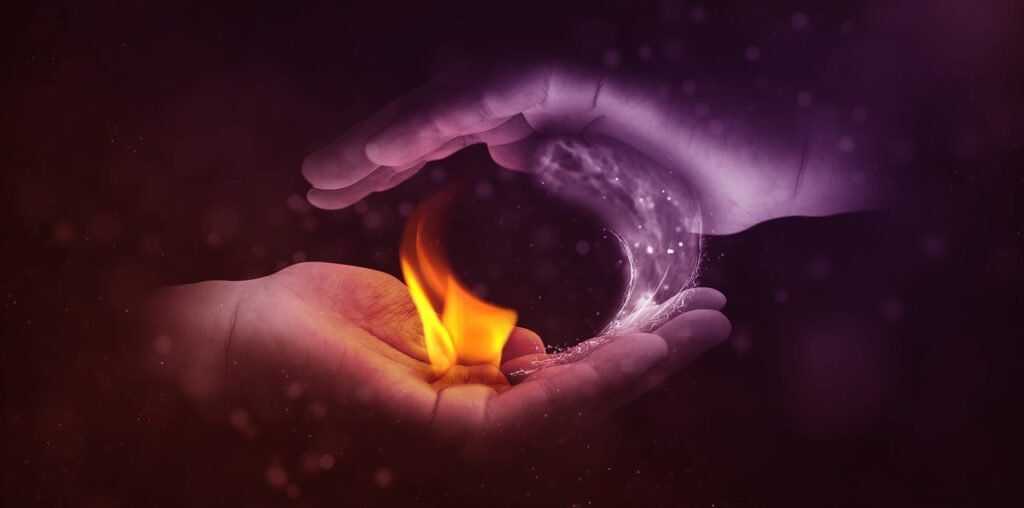In the early days of my Isshinryu journey, it was fairly common to hear references to Yin and Yang energy. For example, “Joe is aggressive, he has a lot of Yang energy.” Or, “Susan is very calm, she has a lot of Yin energy.” There’s more to the concept of Yin and Yang than I can go into in this post. But, the Yin Yang concept is universal to Asian martial arts. It comes from Taoism. But it’s also used in martial arts with roots in the Shaolin Temple…like Okinawan Karate.
In very simplistic terms, Yin is soft, flowing, and feminine energy. Yang, is hard, rigid, masculine energy. The practitioner must cultivate both forms of energy to be complete. Unfortunately, I’ve only met a handful of martial artists who seem to have their Yin and Yang energies in balance.
Karate is an aggressive martial art. Its emphasis on hard striking tends to create students with an overabundance of Yang energy. Karateka must learn to be soft and relaxed. This doesn’t conflict with Soke Shimabuku’s design for Isshinryu. Isshinryu is relatively soft compared to some other styles of karate.
In Okinawan Karate there are two kinds of energy that I’ll discuss; chinkuchi and muchimi. These energies operate like Yin and Yang.
Chinkuchi refers to the discharge of explosive power at the end of your technique. It’s like the crack of a whip. In Isshinryu, it’s the snap at the end of your strike. To achieve chinkuchi your muscles, tendons, ligaments, breath, and mind must be coordinated perfectly at the correct moment of your technique. When your body and mind are coordinated like this, your technique will snap on its own.
What many karatekas are missing is muchimi. Muchimi is heavy, flowing, and sticky energy. A karateka with muchimi sticks to you and feels heavy. They use this energy to guide you in the direction they intend. High-level judo players put on a demonstration of muchimi as they guide their opponent into position, before exploding into their technique.
The other aspect of muchimi has to do with striking. Before you strike your body must be in a relaxed state, which is then quickly accelerated. After impact the strike immediately retracts and returns to a relaxed state. This gradual build-up and release of energy is like a wave crashing onto rocks. It’s the hallmark of muchimi.
A karateka with muchimi and chinkuchi working in harmony can damage internal organs.
Bruce Lee was well aware of these dueling forms of energy:
A gung fu punch is like an iron chain with an iron bar attached to the end and it goes “WANG” and it hurts on the inside.
Karate’s emphasis on hard strikes can make it difficult to develop a balance of energy early on in one’s training. But it’s not impossible. Here are some tips:
- Slow down. A good exercise is to walk through your kata slowly and deliberately. Perform your kata like you were doing Tai Chi. Direct your attention inward and feel each movement. Turn it into a mindfulness exercise. Feel the ground beneath your feet. Pay attention to your breath. Identify the points where you should relax and when you should add tension. Feel as if the power is traveling like a wave upwards from the feet, amplified by the core, and directed out from the striking limb.
- Practice techniques and drills that require contact with another human being. Tai-kitae, grappling, and sensitivity drills will help you develop your stickiness.
- Perfect your stances. Stance training is sadly neglected in many schools. It’s completely absent from modern mixed martial arts gyms. However, good technique begins with stances. The idea is that if you can’t control your body statically, you’ll struggle to control another body dynamically. Start with your horse stance and work your way up to holding it for 5 minutes, then 10 minutes, then 15 minutes or longer. A karateka that can hold a 15-minute horse stance is formidable.
The martial arts journey is long and requires patience. It’s important to realize that black belt is not the end. Concepts like chinkuchi and muchimi take YEARS to develop. Much longer than what’s required to reach Shodan. However, it’s a sign of maturity. The point is to enjoy the practice.




Breaking it down this way helps. I need to rethink how I practice my katas….. and check my stances… We need to have a horse stance stand-off!
I think sayuchin has these concepts of hard and soft in the kata. There are definitely many horse stances in it.
That’s a good observation. Seiunchin kata is from Goju-Ryu, which means hard-soft style.
There is a good reminder of this in our kata that everyone should be aware of. Yang can be characterized by a straight vertical line, while Yin is often represented by a flat horizontal line. When tracing the enbusen (pattern) of Sanchin kata, it moves on a straight North-South line and is representative of Yang while Naihanchi goes East-West and is representative of Yin. Tatsuo Shimabuku was also quoted as saying that Sanchin is like the father and Naihanchi is like the mother to Isshinryu. Interestingly, when we combine those two lines, we get the cross pattern of Seisan. I went into a lot of detail about these different forces in our kata in my 8-codes intensive. I’ll have to teach it again before the year is over.